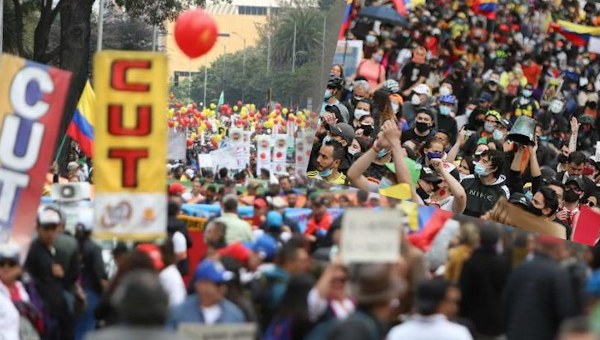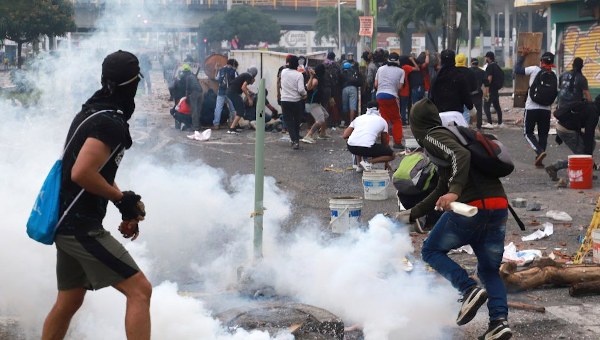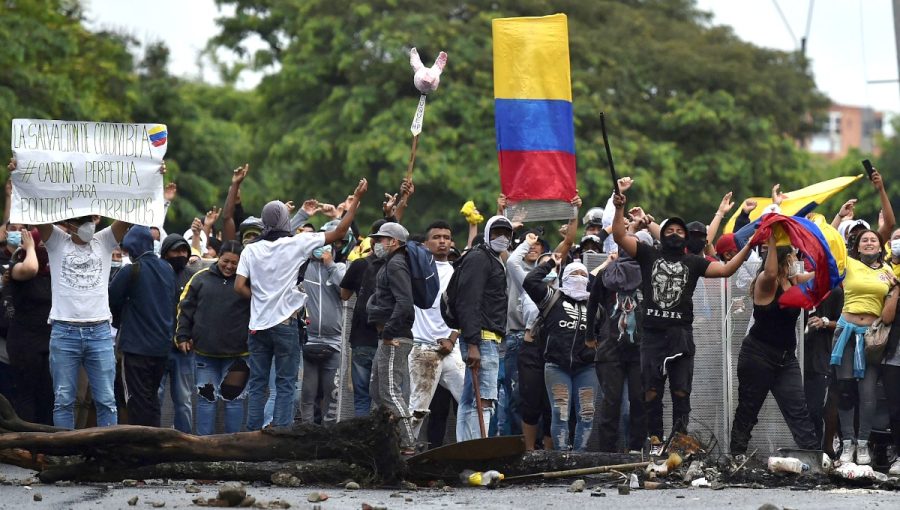Latin America’s Dilemmas Reflected on the Streets of Colombia
In one of the regions contributing most to the global increase in the number of COVID-19 cases and deaths, amid health chaos, unemployment, hunger and escalating inequality, workers, students and young people in the urban peripheries, peasants, small village dwellers, black and indigenous peoples have risen up to defend their lives – against the deadly austerity plans of right or centre-right governments.
Colombia’s Paro Nacional (national strike) on 28-29 April 2021 opened a period of massive daily protests, with an unprecedented unity of urban, rural, indigenous, environmentalist and unemployed youth movements – the latter being the vanguard. Violent clashes have already left 75 people dead, 83 who have lost an eye, 1,468 cases of physical violence, 1,832 arbitrary imprisonments and 28 reports of sexual violence by the repressive forces.1 As of 26 May 2021, INDEPAZ also reported 346 missing persons.
Faced with attacks by tanks and helicopters, the mobilization forced the government to withdraw its tax reform while the economy minister and Chancellor had to resign. The repressive brutality threw fuel on the fire of discontent, isolating the country at the international level (after the outcry caused by the massacre, US President Biden and the United Nations called for calm and dialogue), but did not prevent street demonstrations and road blockades continuing. While encouraging the most barbaric repression, President Iván Duque’s government convened a round table of dialogue with the strike coordinators, not proposing anything in exchange for suspension of the actions. Gustavo Petro, leader of the centre-left Colombia Humana party and the main opposition figure, who sees himself as favourite for the 2022 elections, is taking advantage of this condition to call for social peace and discourage confrontation with Duque. On the streets, however, young people organized for an uneven confrontation said they would rather die under gunfire while fighting than be taken by COVID and hunger.
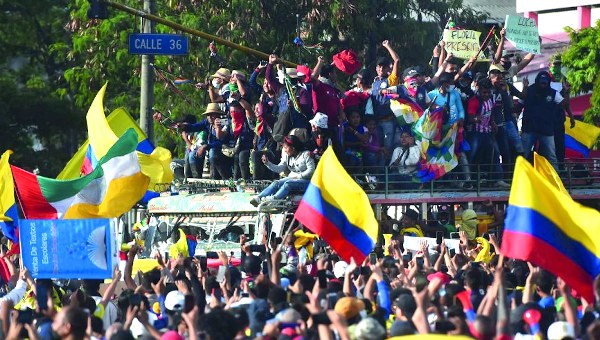
Continental Dilemmas
Whatever the immediate outcome of the current protest, what is happening in Colombia is symbolic of the great economic and socio-political dilemmas of this region of the world. Plunged into a global crisis they had not foreseen, deprived of the extraordinary profits from the commodity boom of the first decades of this century, neoliberal governments and the bourgeoisies need more than ever to resort to austerity plans: reduction of social spending, increases in taxes and prices, privatization – in order to pay the growing public debts. To that end, they deny the growing needs of the people, plunged into poverty and misery increased by the recent recession. They are ready to impose their plans by force with rifles, bazookas, tanks and now helicopters. But at some point, a spark has arisen, such as Duque’s tax increase (or Piñeira’s metro fares increase in Chile, or Lenín Moreno raising fuel prices in Ecuador), and the cauldron of popular fury has exploded.
Rage and mobilizations, even when as heroic as those led by Colombia’s youth, are not enough on their own to reverse the tragic course of a continent colonized by global finance, sickened by COVID and infected by the global phenomenon of the neo-fascist ultra-right. It is certain that social struggles will continue – this is now even more likely due to the impoverishment caused by the pandemic. But the neoliberal counter-offensive of the past 40 years is not over, even though the right has fewer cards than it did two or three years ago and could be further weakened in new battles in the streets and at the ballot box.
The workers and peoples of Latin America will continue to experience neoliberalism and its more or less ferocious “monsters” (Bolsonaro, Duque, Piñera, Lasso, Lacalle). They will have to learn from this. Just think of Ecuador: how will the banker Lasso manage to impose his recipe of “belt tightening” and subjecting the country to the diktats of financial companies, in the face of a complex society, organized and experienced in overthrowing or wearing down the governments that face it? The next period will be marked by more confrontations and social upheavals. We will have a better chance of winning partial victories if the institutional left does not dampen the will to fight and hinder the self-organization of the people, with its well-known tendency to channel everything into elections.
The unprecedented global economic crisis raging today and the intensification of the confrontation between the United States and China make it impossible to repeat a new period of stability modelled on a time when the United States, the European Union, China and Russia coexisted without major tensions. The examples of Ecuador, Bolivia and Chile indicate a growing social and political space for the construction of anti-capitalist alternatives.
Chile’s Political “Earthquake”
The pandemic disaster, from the Rio Grande to Patagonia, has not prevented political and ideological struggles and clashes from affecting elections. Chile is perhaps the most advanced example. The result of the “mega-election” on 15 May 2021 showed a resounding defeat for the right – which failed to obtain the two-thirds of the constituent deputies needed to veto the anti-neoliberal advances. The “respectable left” of the Concertación alliance (Socialist Party and Christian Democracy), which governed the country for 24 years (1990-2010 and 2014-2018), was also defeated. This election propelled forward alternative left-wing forces, such as the Communist Party and the groupings of what was the Frente Amplio (Broad Front).2 Above all, it symbolized the invasion of Chilean institutions by “independents,” many of them from the anti-capitalist left.
The phenomenon of independents in Chile – candidates who emerged on the fringes of parties, sometimes on the lists of left-wing parties, but mainly through social movements or community-based lists, and who are now constituent deputies, governors, mayors or municipal councillors – added to the high abstention rate (almost 60%), confirms the breadth and depth of the crisis of representativeness of the Chilean political system over the past 31 years.3
The composition of the Constitutional Convention also reflects the scale of the popular victory: gender parity, guaranteed participation of indigenous peoples (17 seats out of 155), the possibility of candidacies and coalitions outside the traditional parties. It is the first Constituent Assembly in history where the number of men and women is practically the same: 78 and 77 respectively. The breakthrough of women in Chile to occupy representative space was so significant that the parity mechanism was applied (it was pre-established that there would be an equal number of women and men candidates, plus an adjustment mechanism that would guarantee equality in all cases) to ensure the same number of men, since 84 women and 71 men were elected. In other words, 7 women had to give way to men to guarantee balance! These elements can only be explained by the grandeur and depth of the October 2019 anti-systemic uprising, as well as by the strength of the struggle of women, youth and indigenous peoples.
Ecuador and Bolivia
In the same context of tectonic social plates in motion within societies, elections were held in two other Andean countries in early April 2021.
In Ecuador, banker Guillermo Lasso defeated Andrés Arauz, heir to Rafael Correa (57.58% versus 47.48%) in the second round of the election. In the first round, in February, the tiny difference between Lasso and Yaku Pérez of the Pachakutik Plurinational Movement was challenged by social movements, reinforcing indigenous people’s option of calling for an “ideological” spoiled vote. As a result, the government of Ecuador is back in the hands of a direct representative of the business class, for the first time in 35 years. Lasso has an ultra-neoliberal programme but also the terrible contradiction of facing an undefeated people and a left-wing opposition with a large legislative majority, which elected a Pachakutik deputy to the presidency of Parliament.
In Bolivia, the elections for the government of the departments of La Paz, Tarija, Chuquisaca (where Sucre is located) and Pando were defeats for the MAS (Movimiento al Socialismo). Its candidates lost in all these regions, although Evo Morales’ social and political movement remains the only established national party. The MAS secured the government of three of the country’s nine departments (Cochabamba, Oruro and Potosí), as it did in 2005. It lost in important cities like La Paz (where a former Añez minister won the mayoralty), Cochabamba and the strategic El Alto.
These results and, in particular, the performance of candidates linked to movements that once belonged to the MAS or that have a MAS base (such as former Senator Eva Copa, now mayor of El Alto, and the elected governors of La Paz and Chuquisaca) have heightened the internal debate in Evo Morales’ party-movement, where the choice of candidates “handpicked” by the former president is strongly questioned. The great party-movement, heir to the struggles and victories of past decades, is now divided into three currents: that of Evo Morales, eager to transform it into a Bolivian version of Maduro’s PSUV, in an obvious authoritarian direction; also, although very close to Evo, the more technocratic neoliberal grouping represented by the current President Luis Arce; and finally that based in Bolivia’s heartlands, which identifies with Vice-President Davi Choquehuanca – against the approach that Evo intends to imprint on the “political instrument.”
No Rising “Conservative Cycle”
From this general picture, together the ongoing conflict in Peru to guarantee the election to the presidency of the left candidate, Pedro Castillo, we can indicate some elements that will shape the political situation of the region in the period to come. The multifaceted crisis of global capitalism is expressed regionally through the deep crisis of bourgeois democratic regimes (more or less serious from one country to another), aggravated and far from being resolved by the rise here and there of neo-fascist alternatives. The failure of the neoliberal options of the beginning of the century (Carlos Menem in Argentina, Fernando Henrique Cardoso in Brazil, Enrique Peña Nieto in Mexico, Sebastián Piñeira in Chile, Gonzalo Sánchez de Lozada and Carlos Mesa in Bolivia) and the absence, for the moment, of a new type of anti-capitalist left, indicate that the next confrontations will take place between the neoliberal-oligarchic options (more or less weakened) and the heirs of the so-called “progresismo” who ruled for much of this century.
Despite all the differences between the region’s societies (experience of struggle, organization, recent defeats or victories), the indigenous capitalist alternatives, deeply linked to the United States, do not have projects capable of providing the responses in terms of economy, democracy and national sovereignty needed to overcome the health, environmental and social tragedies of the COVID world. Their plans for over-exploitation and authoritarianism (open or disguised) will continue to clash with popular demands for vaccinations, hospitals, jobs, income, education, housing and transport and, above all, the right to organize and fight for life.
There Will be no Return to “Progresismo”
A “new cycle” of so-called “progresismo” has not begun and is not likely to begin. “Progresismo” is a debatable category referring to experiences as different as the processes in Venezuela and Bolivia (with frontal struggles against imperialism) and the social-liberal processes of the Chilean “Concertación,” the Uruguayan Frente Amplio and the PT in Brazil (the latter, moreover, with sub-imperialist pretensions and practices). In other words, it is unlikely that the regional hegemony of centre-left or left-wing governments with greater or lesser anti-imperialist traits capable of promoting a certain redistribution will be repeated. This does not mean denying the importance of victories against the right in Bolivia, Mexico, Chile, and Peru, or ruling out the possibility of somehow supporting Lula’s return to Brazil’s government, in order to defeat the neo-fascist Bolsonaro.
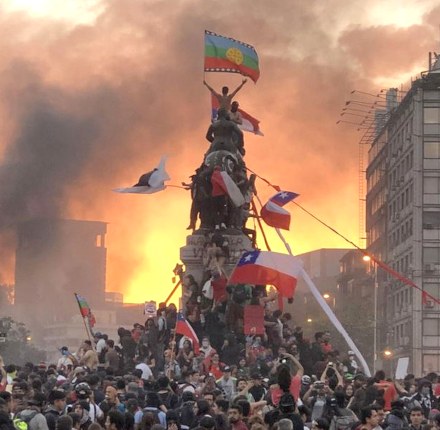
The fact is that the “progresismo” of the first decade of this century, both in its more Bolivarian and more social-liberal aspect, was the result of very specific global (and also national) economic and political conditions, which will not be repeated. The relative success of the so-called “progressive” governments was supported by what was (and still is, given the current situation in Venezuela) their structural limit: they fed on the commodity boom, creating extractivist development models that have tended to reinforce the agrarian-exporting (and therefore colonial and predatory) character of the region’s economies. In their social-liberal version they consciously built class coalitions between popular forces and more or less broad sectors of the ruling classes. The latter then disengaged from these projects and do not seem willing to experiment with them again.
Unfortunately, progressive options have not gone beyond this model and continue to call on the people to believe that it is possible to “recommence,” as if nothing had changed, as if they had not already governed and exhausted their supporters and new generations of activists, by clashing with their demands. As Franck Gaudichaud pointed out in a recent interview: “Latin America – like the rest of the world – has entered a period of strong turbulence, which combines a gigantic economic crisis, the very significant impact of the health crisis in structurally unequal societies, the deepening of the biosphere and climate crisis, and finally a new social, political and ideological polarization.”4
It is obvious that it is correct to fight side by side with the “progressive” sectors – even more so when faced with the existence of an ultra-neoliberal and conservative far right – and even, possibly, to join or support them in elections. But the strategic debate is impoverished when thought and action are locked into this tactic – the united front of Lenin and Trotsky. The united front was, more than 80 years ago, a tactic of struggle for the rank and file of European mass workers’ parties, in the fight against growing fascism. It is perfectly correct and necessary to apply a unitary tactic in the fight against authoritarian neo-fascism. But it must be remembered that – apart from Brazil and Colombia – not all South American countries have the possibility of the far right coming to power or staying in power. Latin America’s vast “social left” (both activists and electorate) is not entirely disciplined by the “progressives,” as was the case with the rank and file of European workers’ parties was during much of the twentieth century. It is also necessary to rally those on the left who have never been “progressive” (such as the new generations taking to the streets) and those who have been disillusioned by these “progressives” without moving to the right. The struggle for the consciousness of peoples and workers is not done exclusively by one tactic.
In the great social struggles of recent years, especially the most recent ones (Chile, Ecuador, Peru, Bolivia, Mexico, as in Argentina, Brazil and now in Paraguay and Colombia) hundreds of thousands of anti-system activists have emerged and continue to emerge in the movements of poor neighbourhoods, feminists, environmentalists, anti-racists, indigenous peoples, rural communities, LGBTQI communities, youth and students, teachers and employees from new sectors.5 All these movements put forward demands that come up against the limits of classical “progressivism” because they fight against the living conditions imposed by contemporary capitalism.
The cases of Ecuador, Peru, Chile and Bolivia, although electoral, express the enormous contradictions, problems and challenges that the new Latin American situation brings. Both the right and the traditional left, and those who propose to build a new anti-capitalist, ecological, feminist, anti-racist and democratic alternative, are faced with these problems. These recent examples confirm, each in its own way and with a different intensity, that there is a social and political space – more significant in Chile, Peru and Colombia, less elsewhere – for the construction of anti-capitalist alternatives with programmes that, emerging from social struggles, advance in responses to inequalities of all kinds, racism, hunger, corrupt regimes, police and military violence, environmental destruction, and the ethnocide of indigenous peoples.
The path will be neither linear nor easy, there will be ups and downs, defeats and victories. The big challenge is to be in the struggles, with this new combative generation fighter, to build with it (and not for it) our programme of rupture. •
This article first published on the International Viewpoint website.
Endnotes
- According to data updated on 28 June 2021 by INDEPAZ, “Informe violencias en el marco del Paro Nacional 2021.”
- In 2014-2018, the Concertación parties joined forces with the Communist Party to form the Nueva Mayoria coalition. This coalition lost the presidential elections to Piñeira in 2018 and the CP did not sign the transition pact in 2019, by which the government obtained a halt to the demonstrations in exchange for convening the Constituent Assembly.
- There are several “political camps” among the so-called “independents”: 28 deputies from the Lista Apruebo Dignidad (Frente Amplio and CP), 27 from the Lista del Pueblo (social, community, generally anti-capitalist left movements), 11 more toward the centre-left, called “non-neutral independents” and 10 others elected outside any coalition or “list” – for a total of 76, or 49% of the Convention. If we add the 17 ethnic representatives (all those elected are left-wing in the broad sense), this will make 93 votes out of 155, or 60%. This is without counting the 25 elected members of the Approval List (Socialists, Christian Democrats and small centre-right parties), identified with the social-liberal governments of the Concertación. The right, with 37 MPs, is correct to fear the new Constitution.
- See “Latin America has once again entered a period of strong social and political turbulence.”
- See Paul Mason, The Guardian, 2 June 2021 “How the COVID shock has radicalised Generation Z.”



